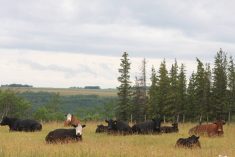Fall sales were off to a strong start when I penned this column last month, with 300-lb. to 400-lb. steers fetching over $5 per pound in some cases. Deb McMillin noted record-high feeder prices in The Markets, with 550-lb. steers averaging $401.79. Where they’re at by the time you’re reading this remains to be seen — McMillin forecasts some seasonal pressure on feeder prices as volumes increase — but producers should see a great return this year overall. Alberta saw a record volume of calf sales the third week of September, with over 100,000 head sold, Canfax reports. That’s the first time weekly volumes have breached 100,000 before late October since Canfax started tracking volumes in the ’90s. Canfax attributed the high volume to special calf sales and deteriorating pastures. Some of those sales were deferred delivery to the fourth quarter.
Speaking of delivery, many areas are likely to see truck shortages this fall, so line up your trucks beforehand. That’s a message coming consistently from the auction marts submitting weekly reports to us, as part of a joint project we have with the Livestock Markets Association of Canada this year. You can find those auction mart reports at our Calf Central page, along with feed market analysis and more seasonal information.
Many are wondering how long this market will run high. Jerry Klassen addresses that question in our October issue by looking at the economy and consumer spending. Many readers will remember the high interest rates of the ’80s — as high as 20 per cent in the early part of the decade. For the sake of anyone with a large mort- gage or farm debt, I sure hope the Bank of Canada curbs inflation long before we see those levels again. However, as Klassen writes, we are now seeing the highest interest rates since the ’80s, and he expects consumers to tighten the reins on their spending next year. As they rein in spending, he thinks beef demand will slow in 2024 as well. Read more in his column on page 41.
Read Also

Improving soil health on the ranch
Yamily Zavala, PhD, talks soil health for farmers and ranchers at a grazing club field day at Paradise Hill, Saskatchewan.
Klassen’s not the only one concerned about beef demand. In Prime Cuts, Steve Kay writes of a recent drop in U.S. beef demand during and after Labour Day that caught him and several other market watchers by surprise. While demand for ground beef is holding up, other items are lagging. Kay writes that they don’t have a good explanation for the suddenness of the shift, but “months of record-high retail prices” are probably behind the switch to pork and chicken.
It’s not just Americans facing higher retail prices. In our News Roundup section, Melissa Jeffers-Bezan writes of a project between the Saskatchewan Stock Growers Association and BetterCart Analytics documenting ballooning retail prices and how that breaks down to different players in the supply chain. Since the 1970s, the producer share of the dollar has dropped substantially, the retail share grown and the packer share remained steady. Between January 2020 and March 2023, some Canadian cities saw pot roast prices increase by about 50 per cent, or, in the case of Oshawa, Ont., 62.98 per cent. Some places were seeing $30 per kg or better this spring, but that wasn’t consistent.
For example, while prices rose nearly 50 per cent in Moose Jaw and Prince Albert, Regina and Saskatoon saw much smaller increases, just over 11 per cent. Many other larger centres also saw larger increases overall. The analysis raises many questions, one being why some cities are seeing drastic price increases and others more moderate price bumps.
The big grocery chains have been grabbing headlines lately, disproving that old saying that all publicity is good publicity. Back in June, Susan Krashinsky Robertson, writing for the Globe and Mail, noted that a parliamentary committee recommended a “windfall tax” on large grocery chains found to be making excessive profits.
The same article covered a report by the Competition Bureau on the grocery industry, which stated that more competition is a “key part” of checking grocery prices. Five grocers control 80 per cent of the retail market in Canada.
Food prices in this country are rising faster than we’ve seen in 40 years. In the last two years, grocery prices have gone up by about 18 per cent, Robertson writes. The bureau found gross profit margins on food have grown “by a modest yet meaningful amount” in the last five years.
The Competition Bureau had four recommendations to deflate retail food prices:
- A “grocery innovation strategy” that will encourage online food retailers and other new types of grocery businesses.
- Create policies that support independent grocers’ competitive abilities and encourage international retailers in Canada, increasing competition.
- Harmonize price listings so people can compare prices of similar items from different stores on a per-unit basis. This would help people spot “shrinkflation.” Quebec is already doing this.
- Reduce real estate restrictions so new stores can more easily open —for example, sales agreements that restrict the opening of a grocery store in a location near an existing or another future store. Australia, New Zealand and Britain have already cut back these types of property controls.
The bureau also suggests updating laws to prevent consolidation that reduces competition in the grocery market.
Speaking of laws related to the grocery business, the Globe and Mail also ran an opinion piece by Tony Keller on the pressure the big retail chains are now facing. Keller noted that on June 13, 2020, three big grocers cancelled the $2-an-hour worker bonus from early stages of the pandemic. Top brass at the grocers had been in contact before this. Such wage-fixing agreements are now banned under the Competition Act, as are “no-poach” agreements.
Ranchers and farmers in this country are very familiar with the benefits and travails of running a business in a highly competitive industry. Those still in the beef business have been through lean times, surviving all kinds of adverse weather and grinding economic conditions, while delivering a high-quality, nutritious food. Enjoy the good returns in the coming months — they’re well-deserved.
















